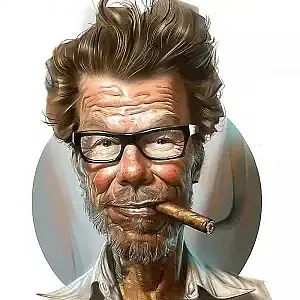“In reality, we’re a plutocracy: a government by the wealthy.”
— -William Ramsey Clark, American activist

Automation renders many humans obsolete. The legendary struggle of John Henry, immortalized by Johnny Cash’s famous ballad, serves as a cautionary tale for institutions like today’s longshoremen. This epic story of muscle against the relentless march of the machine reminds us that the essence of our humanity lies not in our ability to compete with technology, but in our unwavering ability to adapt.
In the folklore of American history, the story of John Henry rises like a Phoenix. A man whose grit and strength were pitted against a steam-powered hammer. John Henry, with his sheer determination, won the race but at the cost of his life. This tale is more than just a legend; it’s a reflection of the timeless struggle between human labor and mechanical innovation used in thriving plutocracies.

John Henry is a blend of myth and reality. According to legend, John Henry was a freedman who labored as a “steel-driving man” on the Chesapeake & Ohio Railroad. The folk hero, known for his incredible strength and endurance, inspired the famous ballad.
Though the story of John Henry may seem tragic, it embodies a hopeful message: the unyielding human spirit. As automation and AI continue to evolve, so too will humanity’s role. As you will read, we are not being replaced; we are being redefined. With change comes the opportunity to explore new frontiers. We will not only adapt but flourish, discovering new capabilities within ourselves.
Historical Context and Strikes
Today, we face a similar challenge. In 2024, longshoremen on the East Coast of the United States went on strike to oppose the automation of their work. This would have been a death blow to a struggling American economy that could destabilize the world. Labor’s plight mirrors countless instances throughout history where technology threatened to replace human effort. The Luddites of the early 19th century protested against textile machines, fearing the loss of their craft. Fast forward to the 21st century, we see this in the form of automated warehouses, driverless trucks, and AI-driven customer service.
California Governor Gavin Newsom (my home State) just signed AB 2876 which gives Government exclusive control over AI information. History tells us that where California goes, so the world follows. What would the modern John Henry do? Or, what are the tycoons doing to today’s John Henry?
Military Examples
Let’s weave in the John Henry story here. Like John Henry, who used his hammer with all his might, soldiers during the American Civil War had to adapt to rifled muskets and ironclad ships. The infantry has changed exponentially since I was on active duty in the 1990’s. We were the tip of the spear. The introduction of these technologies didn’t just make battles more destructive; they acted as force multipliers, changing the very nature of warfare. The battlefield became a proving ground for human ingenuity.
War is the author of innovation. During World War II, the introduction of radar revolutionized naval warfare, allowing ships to detect enemy vessels and submarines at great distances. Radar, much like John Henry’s hammer, became a tool that amplified human capability. In the Vietnam War, the use of helicopters transformed combat, providing rapid troop deployment and medical evacuation. Today, artificial intelligence and autonomous drones are reshaping the new “King of Battle” in modern warfare. These technologies enhance situational awareness, optimize decision-making, and provide a competitive edge. The war in Ukraine has highlighted the application of these technologies, with predictive analytics and autonomous systems playing crucial roles.
John Henry died in his valiant race against a steam powered drill. History immortalized his creed “A man is nothing but a man, but before I let your steam drill beat me down, I’d die with a hammer in my hand.”
AI in Hospitals
Now, let’s turn our attention to the healthcare industry. I suffered a stroke last year and saw how AI is transforming hospitals in remarkable ways. For instance, AI algorithms are being used to analyze medical images, such as X-rays and MRIs, with incredible accuracy. This not only speeds up diagnosis but also reduces human error, leading to better patient outcomes. AI-powered chatbots and virtual assistants are handling routine inquiries, freeing up medical staff to focus on more complex cases. Predictive analytics are being used to anticipate patient admissions, helping hospitals manage resources more efficiently.
Religious Inspiration
Theologians offer a profound reflection on man’s struggle. In Genesis, it is written that man shall toil by the sweat of his brow. This suggests that work is not merely an economic activity but a fundamental aspect of our existence. Ecclesiastes 3:13 states, “That everyone may eat and drink and find satisfaction in all their toil — this is the gift of God.” This message resonates deeply, reminding us that work gives us purpose. Like John Henry, we find our identity in the work we do, even as we face the challenges posed by new technologies.
The Evolution of Labor
From the Industrial Revolution to the Digital Age, humans have always adapted. The cotton gin didn’t eliminate jobs; it transformed them. The advent of computers didn’t eradicate the workforce; it diversified it. With each technological leap, humanity has found new ways to contribute, innovate, and thrive.
Inthe end, John Henry won the race but succumbed to exhaustion, dying with his hammer in his hand. A powerful and haunting timeless tale of man’s march against technology.

In closing, let us embrace the future with the fighting spirit of John Henry, not as a contest of man against machine, but as a journey where both can coexist, enhancing one another. Humanity will endure, as it always has, with resilience, creativity, and hope as long as the Plutocrat’s message isn’t “Let them eat cake.”
